Hello Christmas Island!
Welcome to Christmas Island. Looking down at a working commercial jetty, I am awestruck by the vista. It is surrounded by aqua blue ocean with shallow coral reefs reaching the shoreline. And the sky is a matching crystal blue…
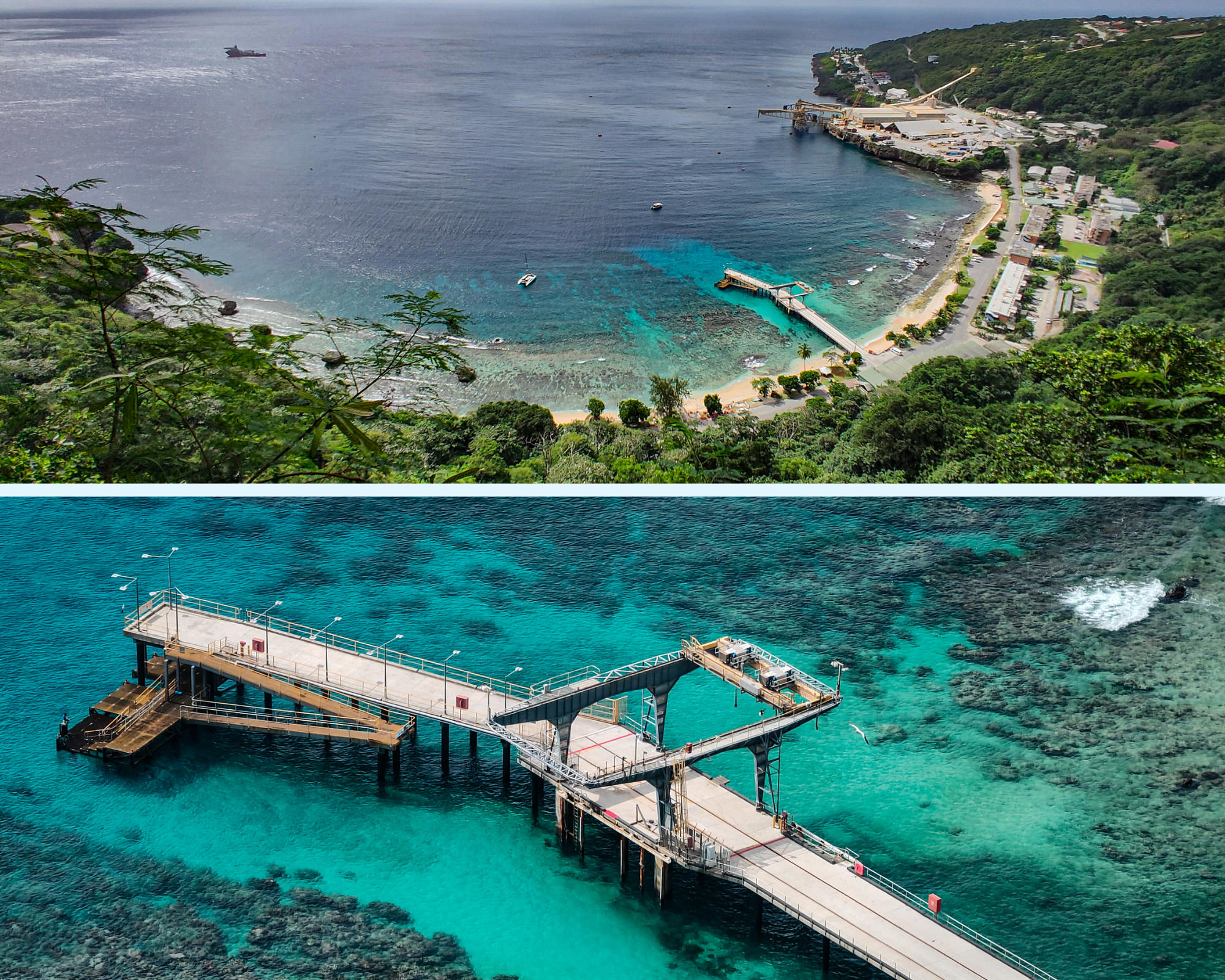
BOTTOM: The working commercial jetty in Flying Fish Cove is surrounded by coral reefs
It is hot and very humid, but with a welcoming soft breeze. Silently pondering this awesome sight and capturing the moment in my memory, I am totally alone. Or so I thought.
A Unique Experience for Lovers of Wildlife
I suddenly have a sensation of being watched. From the corner of my eye, I notice a Brown Booby bird, looking at me rather curiously. About a metre away, it is standing on a tiny rocky outpost, right on the edge of the steep craggy cliff.
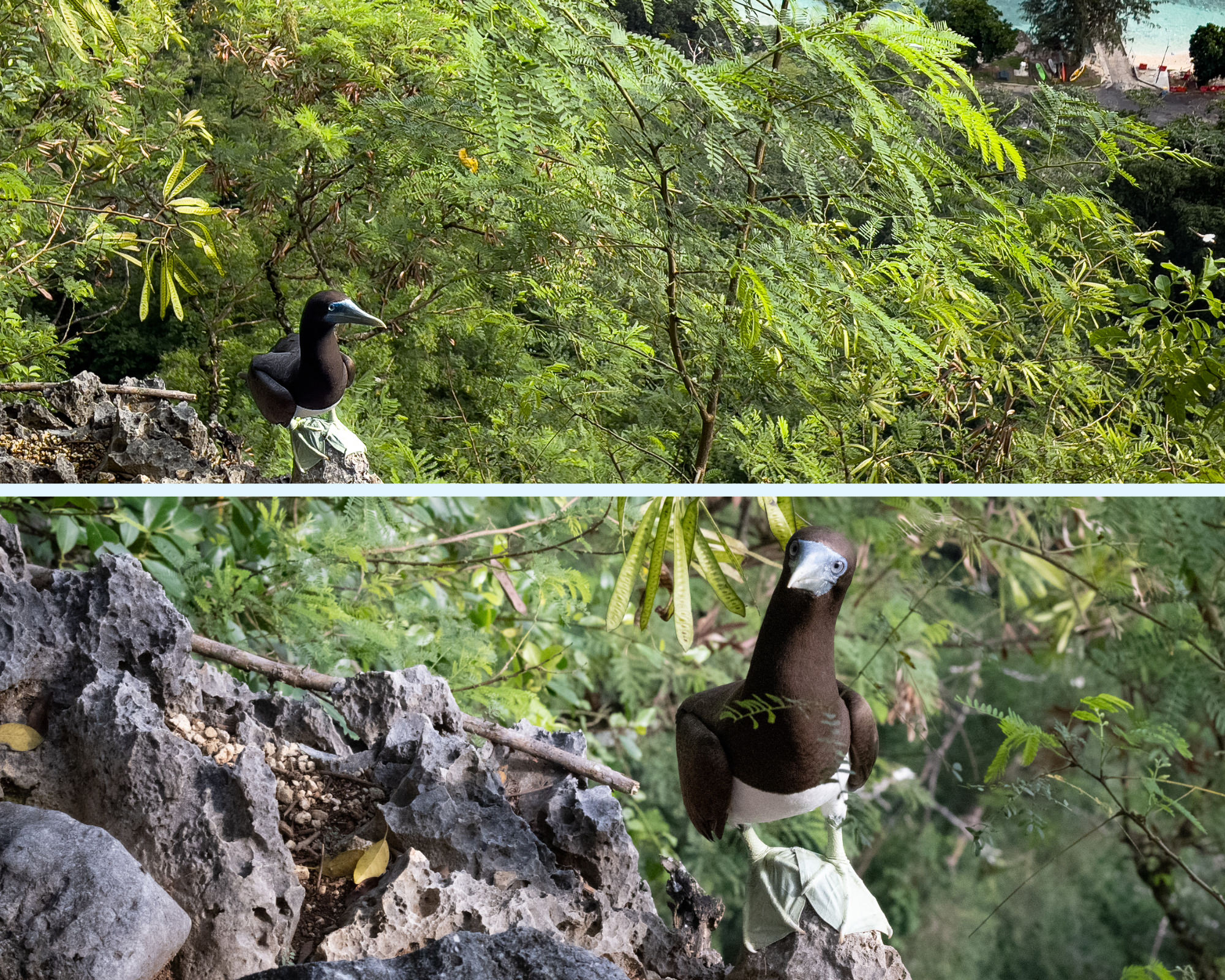
One small sideways step and it could plummet 150 metres down to the road below. It cocks its head, staring right at me. Appearing somewhat cross-eyed, I laugh.
Only on Christmas Island, I think to myself. God, I LOVE this place!
So Where Am I?
Territory Day Park Viewpoint
I’m at Territory Day Park lookout on Christmas Island. As part of a scuba diving group of 17 people on a week-long vacation and the token non-diver in the group, I am taking time out to explore the island whilst the others are out diving.
The lookout is 150 metres above sea level, its small platform erected right on the edge of the precipice overlooking Flying Fish Cove.
The Cove is the site for some of the best snorkeling on the island, as well as being the most popular area for swimming by both locals and tourists alike.
Territory Day lookout is also one of the best vistas on this wonderful unique island in the Indian Ocean. From here you not only get spectacular views of the Cove itself but also the historic but still operating phosphate mine loading facility.
And let’s not forget the wonderful birdlife. This is a top spot for spotting Christmas Island frigate birds gliding about on thermals whilst trying to rob Booby birds of their digested fish catch. Or the rather curious daytime flying Christmas Island fruit bats mixing it with the frigates and boobies.
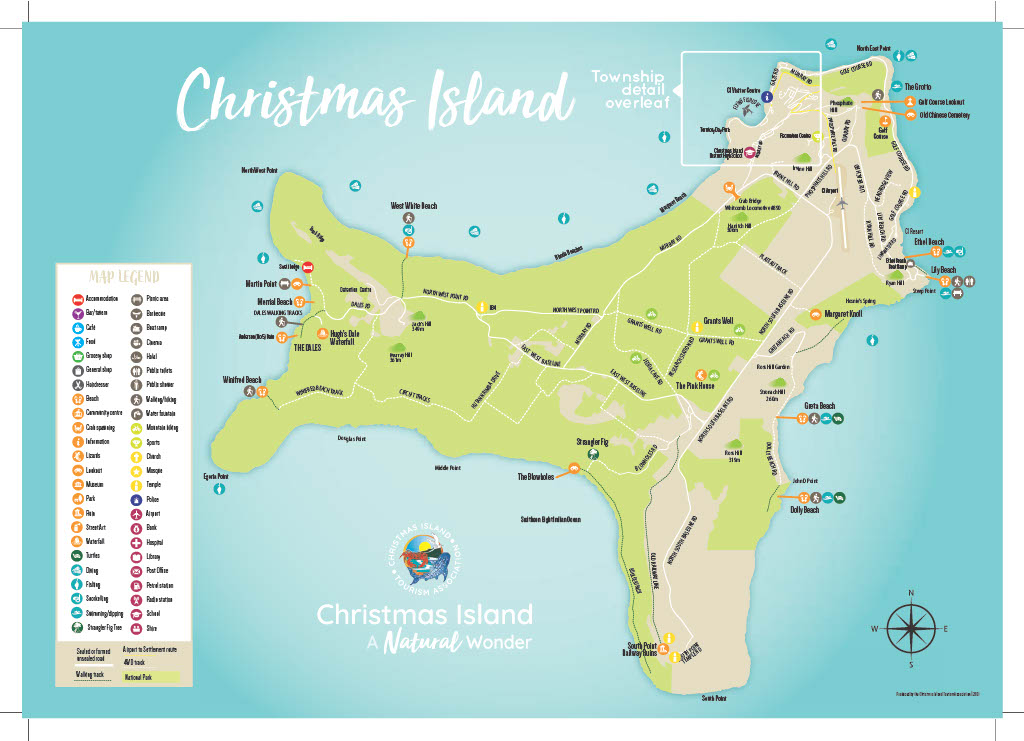
Territory Day Park Loop Walk
Territory Day Park is just one of the easy walks on Christmas Island. Sited in Drumsite township it is a great introductory 30-minute rainforest nature trail looping back to the carpark.
Signposted boardwalks scattered around the trail help experience the unique lush island semi-deciduous rainforest. Tall Nyatoh trees and their large, sculptured buttress roots are admixed with Sea almond and Strangler fig trees set amongst huge limestone rocks.
Numerous infamous Christmas Island red crabs scurry amongst the leaf litter cleaning the forest floor. You may even see a large robber crab along your way.
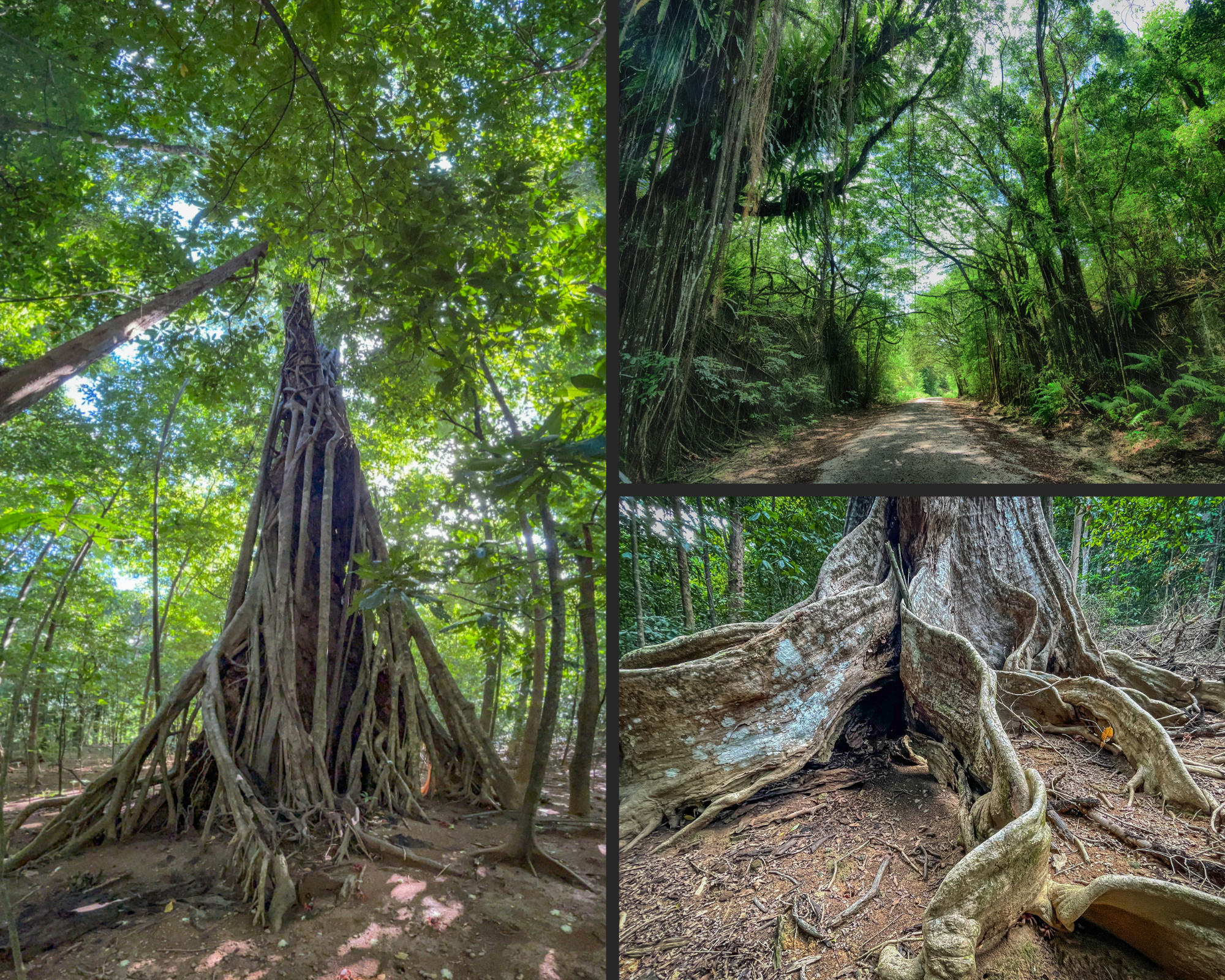
RIGHT TOP: A stunning rainforest canopy on a section of Lily Beach Road
RIGHT BOTTOM: Very impressive Nyatoh buttress tree roots, some a metre high
Christmas Island, Australia’s Answer to the Galapagos
Where is Christmas Island, you may well ask? Well, it is a small island in the Indian Ocean, 1500 kms west of the Australian mainland, 2600 kms northwest of Perth in Western Australia, and 380 km south of Jakarta, Indonesia.
At only 135 km sq. it is just slightly smaller than Easter Island. Whilst physically closest to Southeast Asia, it is a Territory of Australia (along with Cocos Keeling Island) and has been since 1958.
As such, it comes under Australian governance. It is English speaking, uses Australian currency, and even has Telstra mobile and internet access (albeit quite limited!). In 2021, the population of Christmas Island was only 1843.
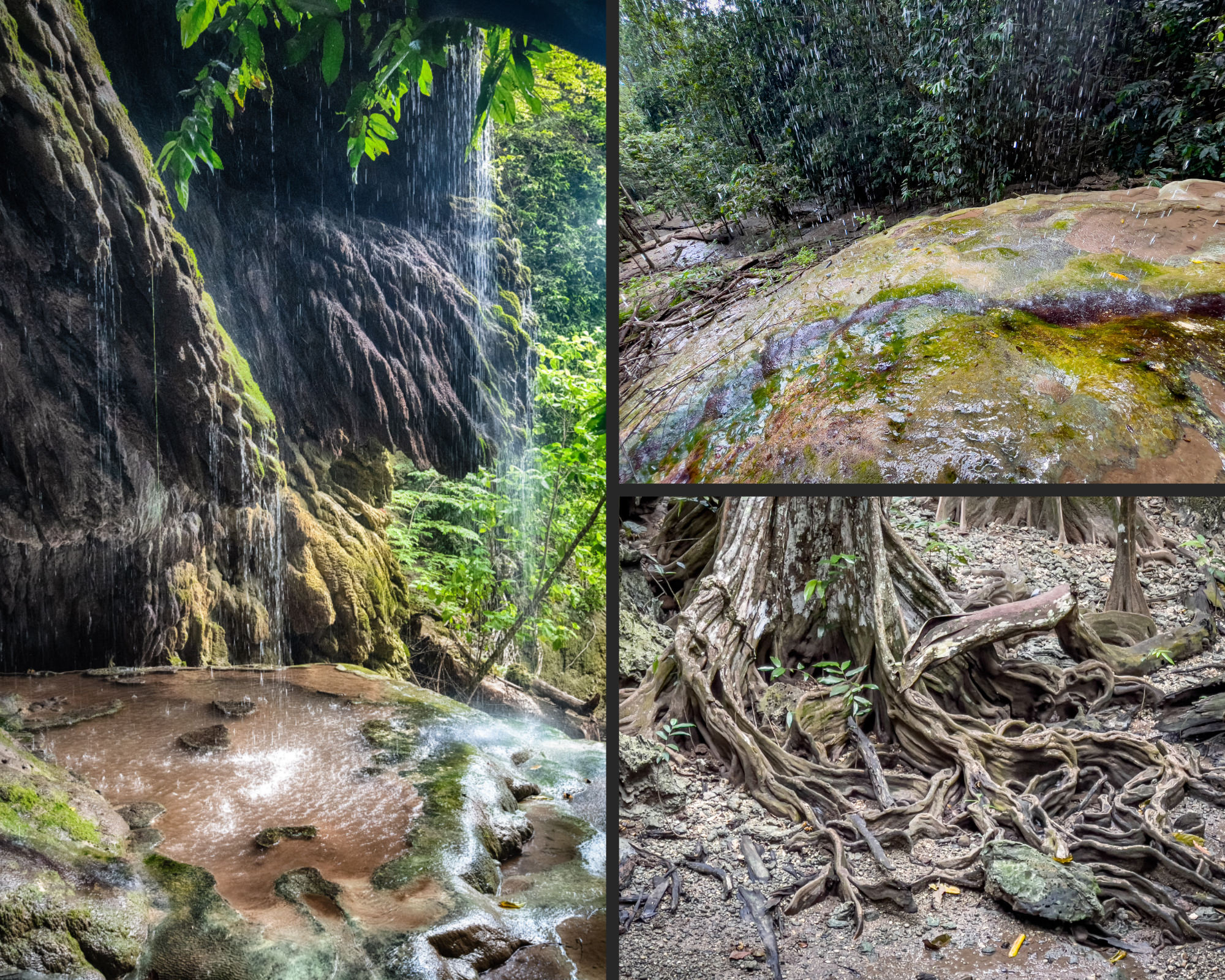
TOP RIGHT: The waterfall spills down mineralised rocks into the rainforest below
BOTTOM RIGHT: Huge Tahitian chestnut trees with their characteristic gnarled root system
Geology of Christmas Island
Christmas Island arose 60 million years ago as a basalt volcanic seamount, some 5000m from the sea floor. The island’s highest point now is Murray Hill at only 361m. But there are a total of 18 mountains on Christmas Island.
The island is made up of limestone and layers of volcanic basalt rock. It is surrounded by a narrow tropical reef resulting in 80 km of shoreline, with a steep drop-off to the sea floor.
Natural rainforests and jungles extend to the steep cliffs, which give way to small, deserted sand and coral beaches of varying accessibility. The easiest to get to are Lily and Ethel’s eastern beaches and the western Merrial Beach (at low tide only) near Martin Point.
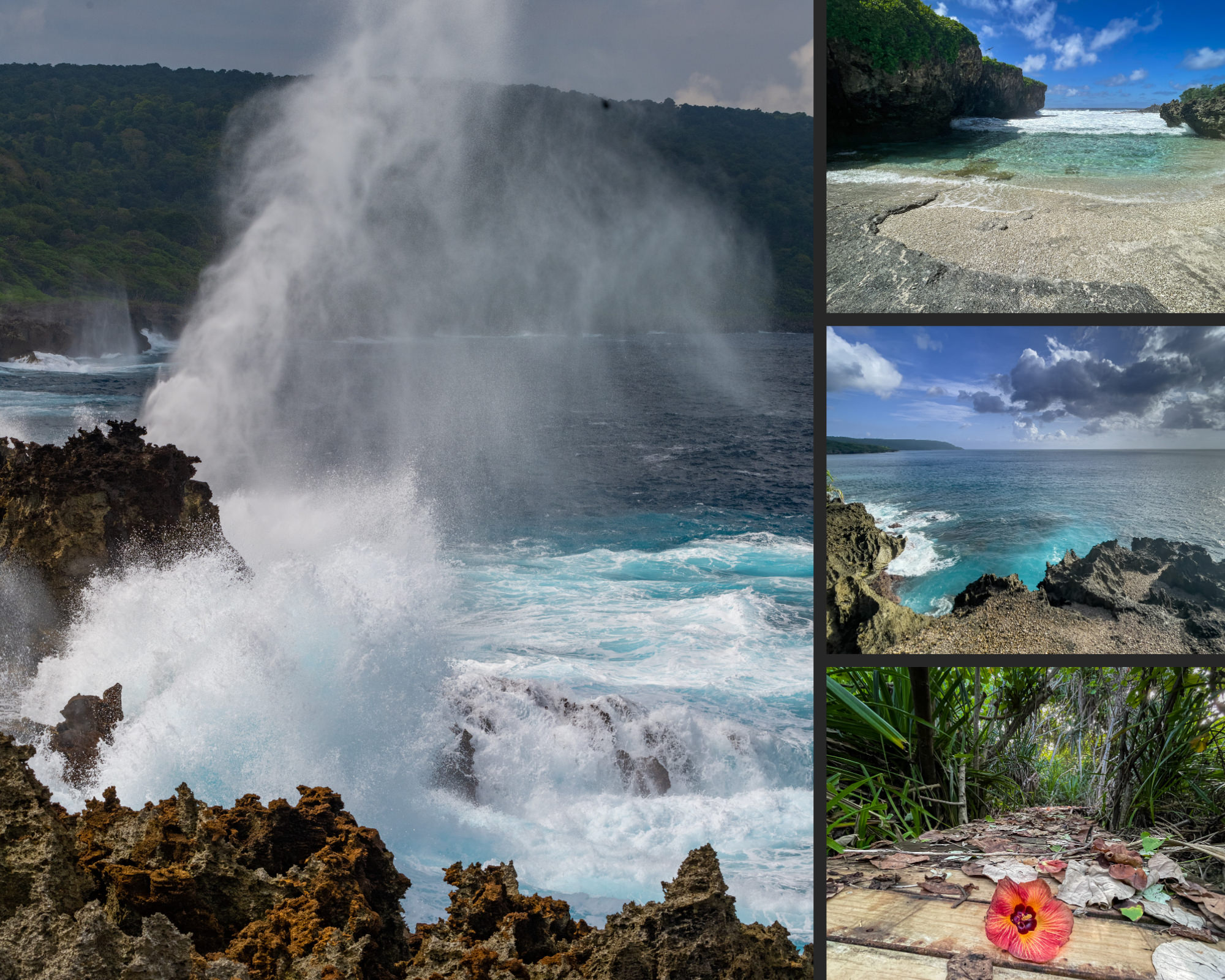
TOP RIGHT: My personal favourite, Lily Beach
MIDDLE RIGHT: The craggy southwest coastline viewed from Martin Point
BOTTOM RIGHT: Walk along the boardwalk at Lily Beach heading towards Ethel Beach and you may see nesting Brown Booby birds along the clifftop
Local knowledge and possibly the use of 4WD vehicles or an island guide are best to get to Greta, Dolly, Winifred, and West White beaches. Use of a personal locator beacon is advised for travel to remote areas. These are loaned for free from the local Police Station.
The force of the ocean has created many coastal subterranean caverns. Thunderdome and Thundercliff are both very popular with divers. But the Daniel Roux Cave is accessible via land at Smith Point as is The Grotto near Settlement township, and the thunderous Blowholes on the southern coast.
What Makes Christmas Island So Special?
There is something for everyone on Christmas Island. A paradise full of natural wonders, it has many endemic creatures not found anywhere else in the world. It truly is deserving of its nickname, Australia’s Galapagos in the Indian Ocean.
The island lends itself to the most amazing opportunities to experience wildlife, awesome land and seascapes, and its stunning coral reefs and other marine life.
Much of the wildlife is relatively easy to experience. Some can be seen right amongst the populated areas on the island, even in the backyard of your accommodation. Others can be easily found on local cliff tops or along the rainforest and beach walks.
Christmas Island’s Unique Crabs
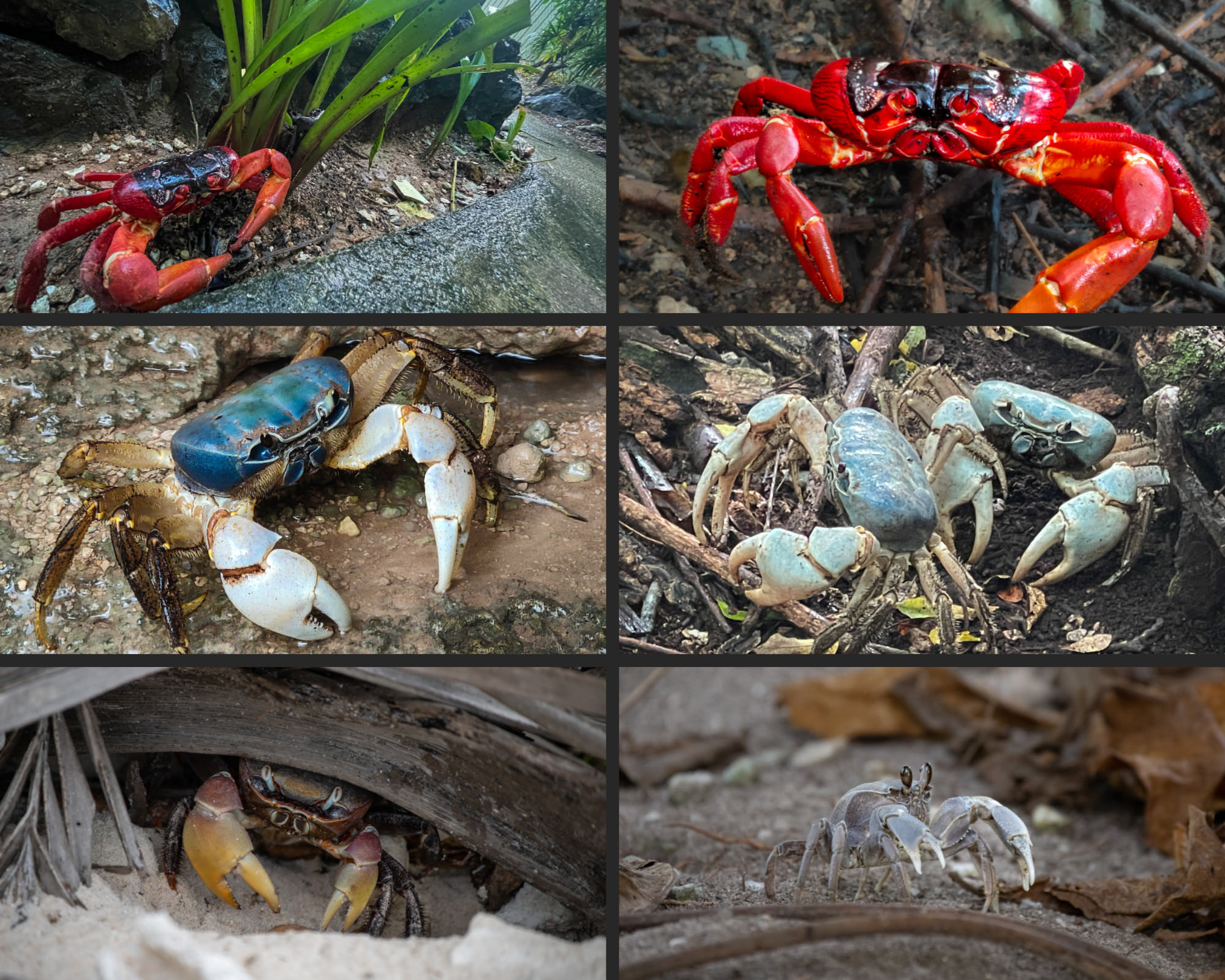
MIDDLE LEFT/RIGHT: Similar-sized blue crabs, photographed at Hugh’s Dale waterfall and Martin Point
BOTTOM LEFT/RIGHT: Some of the other crabs you may come across including a small ghost crab
The Red Crab Migration
If you are like me, the only thing you may have heard about Christmas Island is its infamous red crab migration.
Triggered by the rainy season from October to November, this synchronised mass migration extends from their forest homes all over the island to the ocean.
The landscape of the island becomes a moving carpet of red, making it very difficult to navigate around the island. This is despite the erection of numerous roadside crab barriers, many crab grids, and the single token Crab Bridge on Murray Road.
If the rains stop temporarily, so does the migration, so the actual mass exodus can become split into two or more arms and spread over weeks or 1-2 months even.
The males go first, digging burrows to await the females. After mating, the males head back to the forests, while the females wait for the last quarter of the moon. And the turn of the high tide, en masse they shed their eggs into the ocean.
The eggs become larvae and after over a month, they finally turn into air-breathing baby crabs. These then emerge from the sea and begin their long walk to the forests.
After 4-5 more years, the surviving juveniles become sexually mature. And so, the cycle begins once more.
Christmas Island has a population of approx. 50 million red land crabs, their numbers in recent years decimated by the accidental arrival of the yellow crazy ant. This has also been responsible for affecting the bird population and the now extinct pipistrelle microbat.
Other Island Crabs
The island is home to 20 different species of terrestrial and intertidal crabs, of which only 14 species are true land crabs that only enter the water to spawn.
Coloured Christmas Island Crabs
But the infamous red crabs are not the only coloured crabs on the island. There are also blue, brown, and purple land crabs. But all live in the forests on the island, needing moisture in the soil to survive.
However, whilst very similar in appearance to the red crabs, their blue ‘cousins’ are endemic to the island. They are mostly found around Hugh’s Dale Falls and Martin Point only. One wonders whether something in the waters draining this region gives their carapace the blue hue. Especially as the rocks in the Falls are also a rather blue-green colour.
Other Crabs
Other crabs include ghost, hermit, mottled, and nipper crabs but my favourite is the robber crab, the largest crustacean in the world.
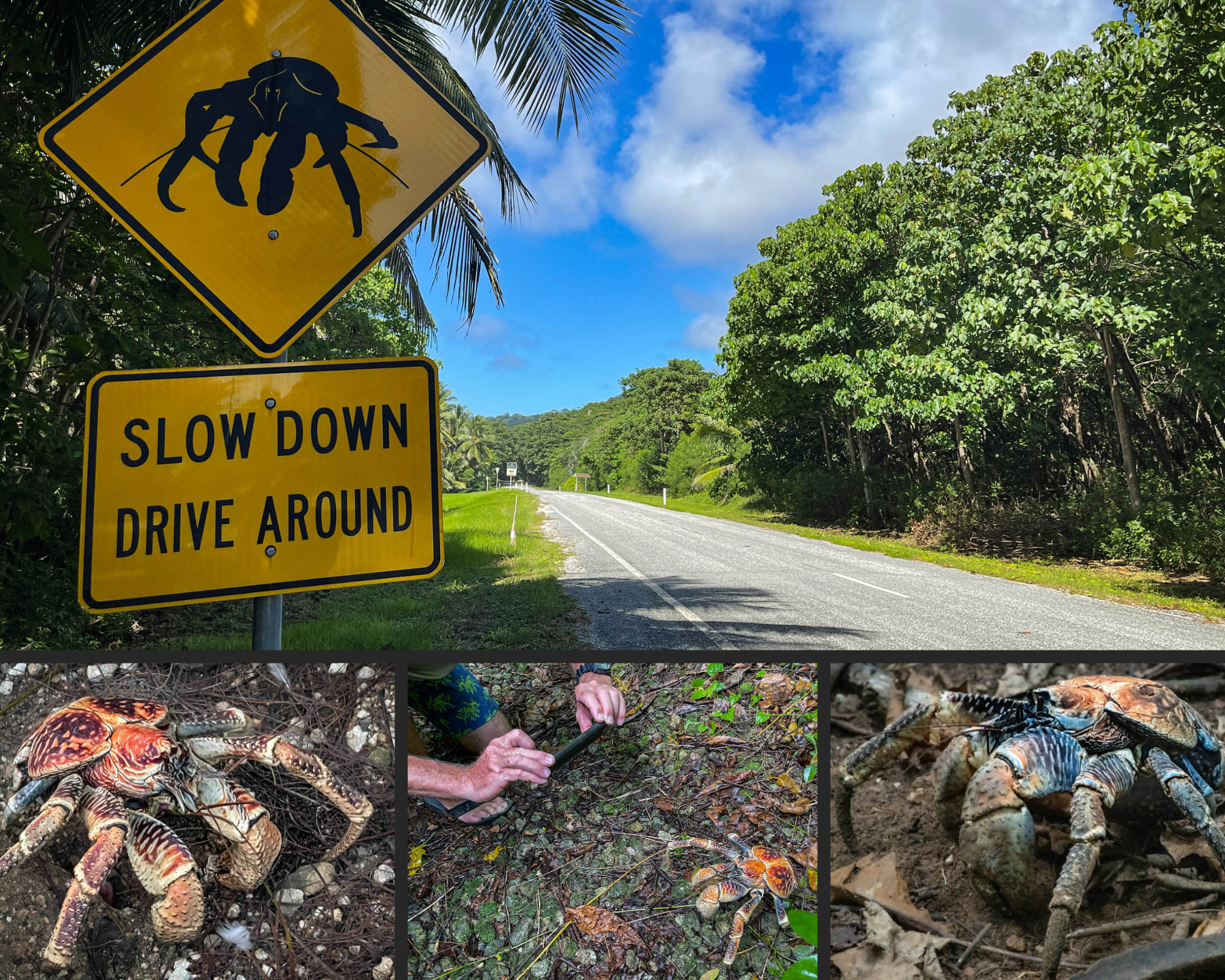
BOTTOM LEFT: Robber crabs come in all colours and sizes
BOTTOM MIDDLE: Photographing a rather ‘small’ robber crab
BOTTOM RIGHT: A stunning dark blue robber – gorgeous!
Robber Crabs
Growing up to 4.5 kg and 1 m in length, they are a truly awesome crab. Being so large, road signs around the island instruct drivers to always drive around and not over robber crabs, as you can do when encountering red crabs.
Robber or coconut crabs tend to be timid and usually move backward when threatened. If given the opportunity, they have been known to run up the trunks of trees to escape a threat. A stunning sight I gather but one I tried to photograph, but unfortunately didn’t get the opportunity in my time on the island!
Birdlife of Christmas Island
Endemic Birds of Christmas Island
The island is an ornithological paradise with many endemic bird species to investigate. My favourite is the Booby Bird.
There are three varieties on Christmas, the largest also being the rarest in the world, the spectacular Abbott’s Booby. We spotted a few around the LB4 lookout and the adjacent section of Murray Road, one of their nesting areas.
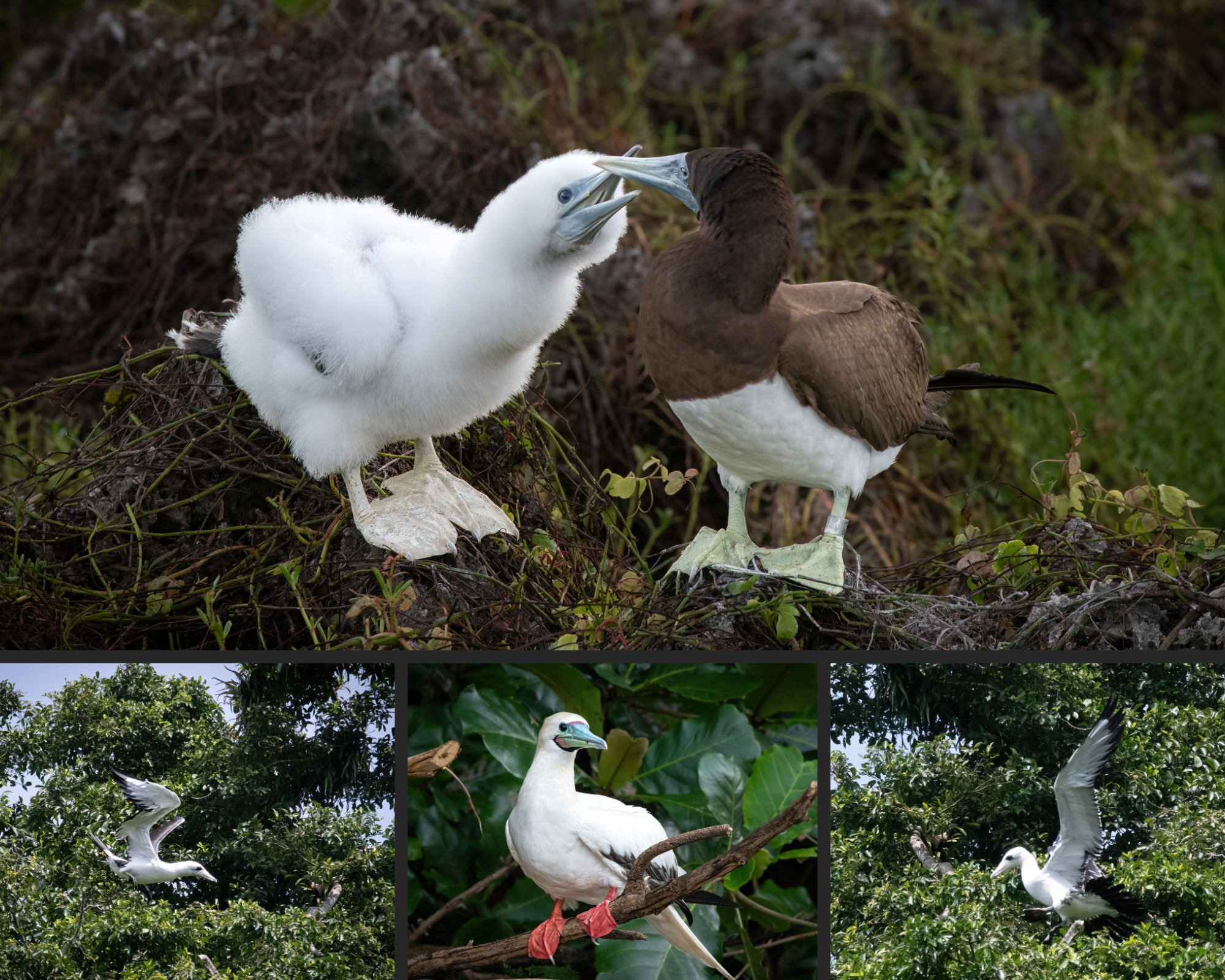
BOTTOM LEFT: A rare Abbott’s Booby coming into land in the tree canopy at LB4
BOTTOM MIDDLE: A Red-footed booby balancing precariously on a low-hanging branch
BOTTOM RIGHT: A nesting Abbott’s Booby bird
The colourful Red-footed Booby has numerous nests along a short section of Lily Beach Road, whilst the largest population in the world of Brown Boobies can be found around many cliff edges, especially around the boardwalks and cliff tops of The Blowholes and Lily Beach.
Other endemic species include the vulnerable Christmas Island Emerald Dove and Imperial Pigeon, the distinctive Christmas Island red-throated Frigate bird, the rather vocal Christmas Island Thrush, the endangered Christmas Island Goshawk, the also vulnerable and optically mesmerising Christmas Island Hawk-owl, and last but not least, the tiny Christmas Island White-eye.
Visiting Birds to the Island
There are at least another 70+ bird species that visit Christmas, particularly due to its proximity to Southeast Asia.
These include the Common Noddy, Nankeen Kestrel, and the Sacred Kingfisher. Noddies can often be seen precariously making their nests in the vertical walls along the cliffs, best viewed from the ocean, especially near the dive site, Perpendicular Wall, or near Lily Beach.
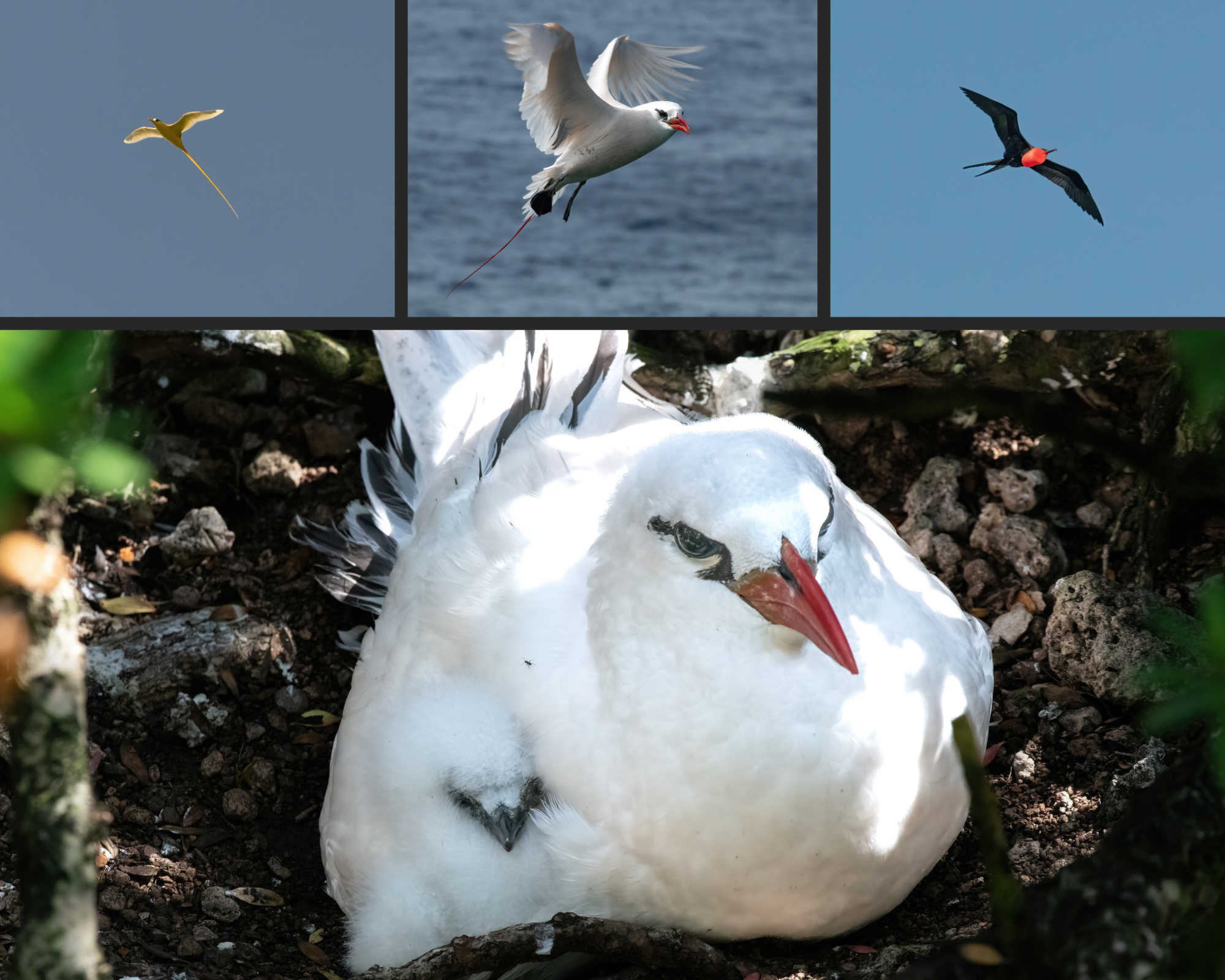
TOP MIDDLE: A Red-tailed tropic bird about to land on a craggy cliff near its nest
TOP RIGHT: A male, bright red-throated Christmas Island frigate bird
BOTTOM: A nesting Red-tailed tropic bird with its little chick
The Silver or White-tailed or Golden Bosun Tropic bird often nests on the tops of the craggy volcanic cliffs. A particular easily accessible spot is around Settlement township near the Historic House. The Golden Bosun especially loves to fly around Flying Fish Cove amongst the swooping Frigate birds and Brown boobies.
Take Your Bird Watching to the Next Level
Whilst you can simply enjoy bird watching or some spectacular bird photography, there is also a great opportunity to delve deeper into the island ecology and even assist in island bird research.
If this applies to you, consider visiting the island during Bird n’ Nature Week, from 30th August to 6th September 2022 for some enticing activities.
Rare Reptiles and Mammals of Christmas Island
Christmas Island Flying Fox
Yet another endemic species whose numbers are unfortunately declining is the Christmas Island Flying Fox. This small black bat weighs less than 500 gm and is found nowhere else in the world. It also has the rare habit of flying during the day as well as at night.
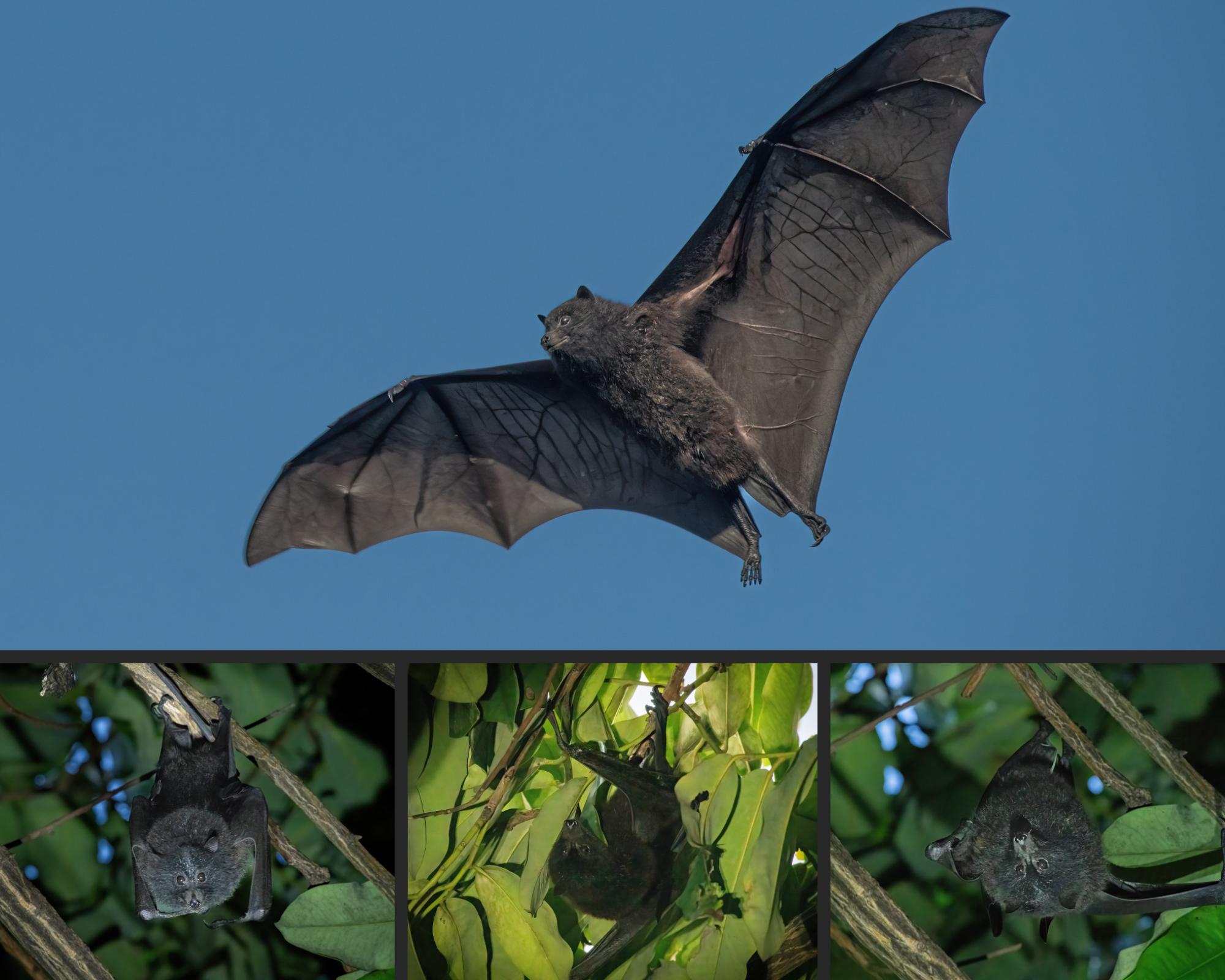
BOTTOM LEFT/MIDDLE/RIGHT: A flying fox feeding inside a native fruit tree in the late afternoon
Thus they can easily be spotted around Flying Fish Cove in the early afternoon, flying amongst the frigate and booby birds.
We even managed to find a particular maturing native fruit tree right on the lawn of Tai Jin House which proved a haven for hungry bats in the late afternoon or early evening.
Critically Endangered Reptiles of Christmas Island
Also endemic to the island, both Lister’s Gecko and the Blue-tailed Skink are creatures whose numbers have been decimated in recent years and are now extinct in the wild.
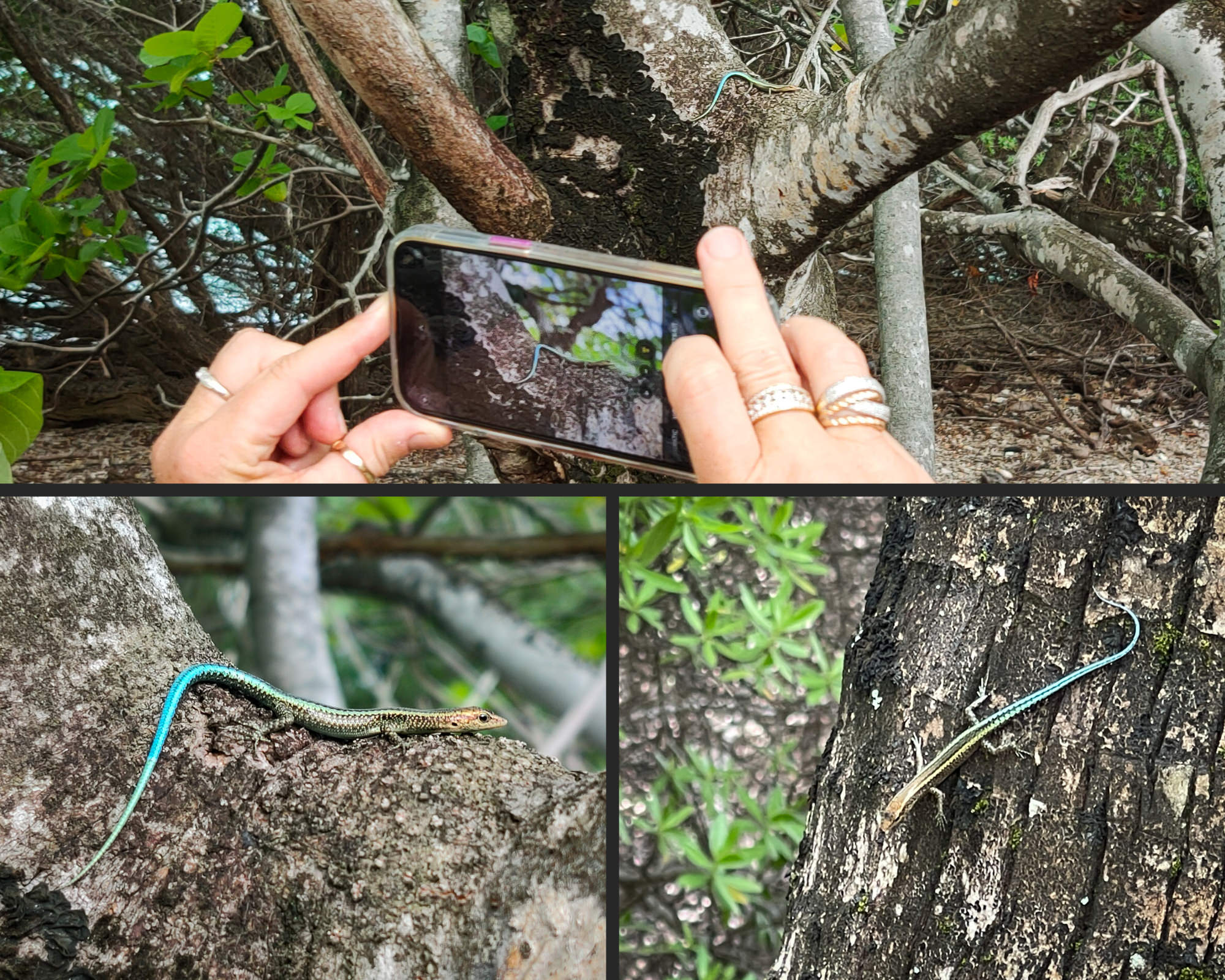
However, captive breeding programs have been reasonably successful and have resulted in a number of skinks being translocated to Pulu Blan in the Cocos (Keeling) Islands.
We were lucky to be able to photograph them whilst there on a self-guided kayaking adventure prior to flying to Christmas Island.
The Underwater Paradise of Christmas Island
Given its geographical position in the Indian Ocean and being surrounded by only a narrow fringing coral reef which rapidly drops off to 400 m deep at many dive sites, Christmas Island offers world-class diving and snorkeling with some of the best water clarity and visibility.
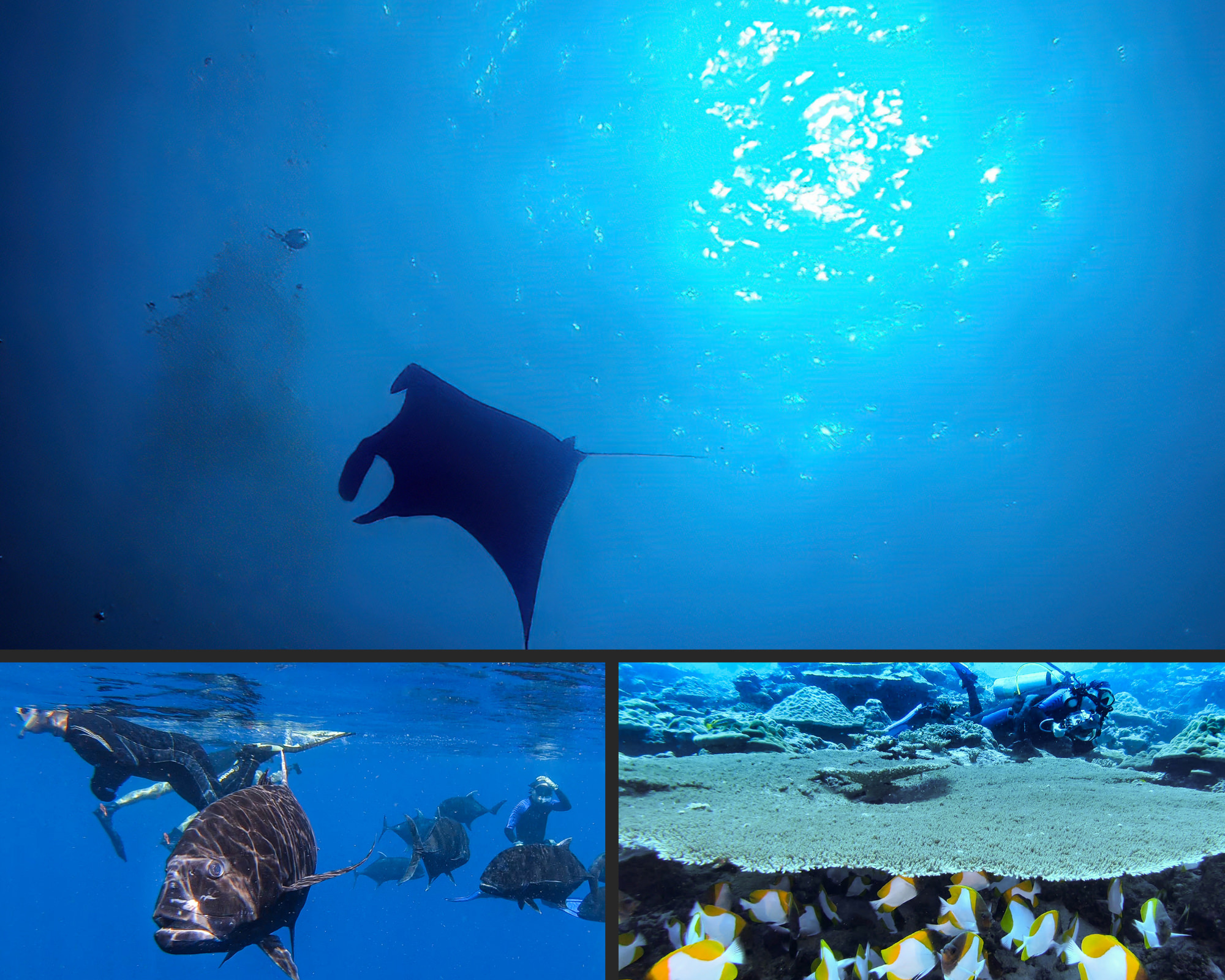
BOTTOM LEFT: Snorkeling amongst a school of giant trevally
BOTTOM RIGHT: Scuba diving amongst huge plate corals sheltering abundant colourful pyramid butterflyfish
The coral reef comes right up to the shore and for snorkellers is best experienced in Flying Fish Cove. Despite the proximity of the Cove to the Phosphate Mining loading dock, the water visibility was quite astounding most days making it very popular with muck divers.
The most amazing un-bleached healthy coral beds, perpendicular walls, drift dives, haunting caverns, and two collapsed wrecks can be experienced all year round.
Large numbers of small reef fish are a common occurrence. But larger fish including spinner dolphins, sharks, giant trevally, rare sailfins, and tuna can also be encountered.
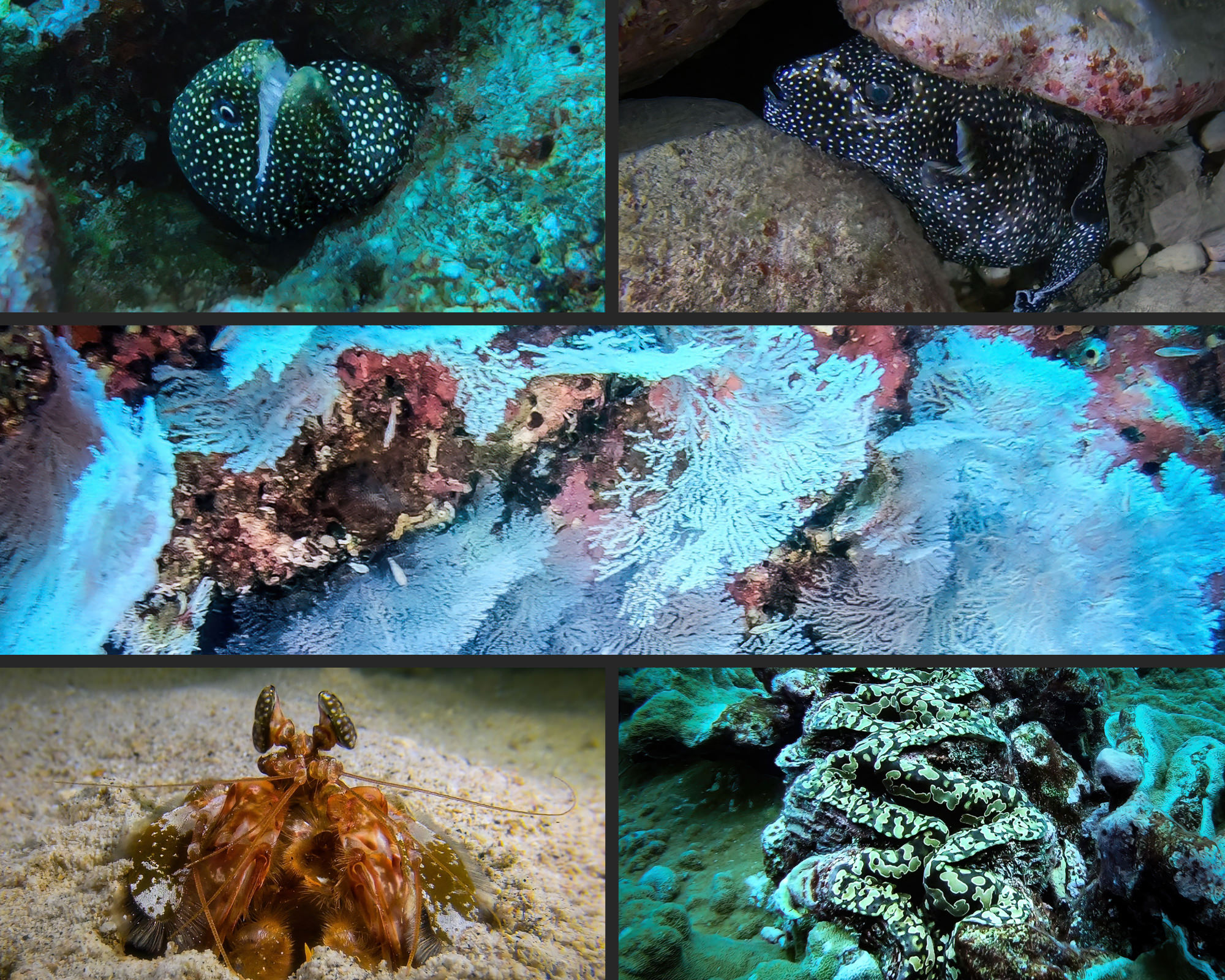
MIDDLE: Multi-coloured gorgonian soft corals
BOTTOM LEFT/RIGHT: A spear mantis shrimp and a giant clam
When in season, hawksbill and green turtles come to nest on Greta and Dolly beaches.
But the crowd favourite, the huge, elegant whale sharks frequent the island during the wet, from November to April, when abundant plankton is in the water. This is often also associated with hammerhead sharks, large manta rays, and groups of smaller mobulas.
History of the Island
Given its small size and remote location in the Indian Ocean, Christmas Island wasn’t discovered until the 1600s when it was spotted by a passing British ship in 1615. The island was christened on Christmas Day 1643 by Captain William Mynors of the British East India shipping company.
Early visitors experienced very difficult terrain which made access to inner parts of the island extremely challenging.
In the 1800s, the Clunies-Ross family settled on the relatively nearby Cocos (Keeling) Islands, using Christmas Island as their source of timber. Flying Fish Cove became the first camp built on the island.
Naturalist Dr. John Murray was the first person to suggest the island may be a source of rich phosphate (from centuries of exposure to bird guano). Expeditions in the late 1800s collecting soil samples confirmed his suspicions.
Phosphate Mining on Christmas Island
The year 1891 marked a 99-year joint lease between Dr. Murray and the Clunies-Ross family to mine the high-grade phosphate. Migrant workers from China, Malaysia, and India then and now still form the principal mine workers, resulting in the rich multicultural society of the island.
Since the 1980’s however, the phosphate deposits are becoming exhausted. Coupled with drought and low global prices the mine temporarily closed in 1987.
The continuing conflict between mining and conservation led to the creation of the Christmas Island National Park in 1980. Over recent years, the Park has expanded its cover. The park now occupies 85 m2 or 63% of the island preserving its natural state (unlike Nauru which has been completely devastated by mining and bad land management).
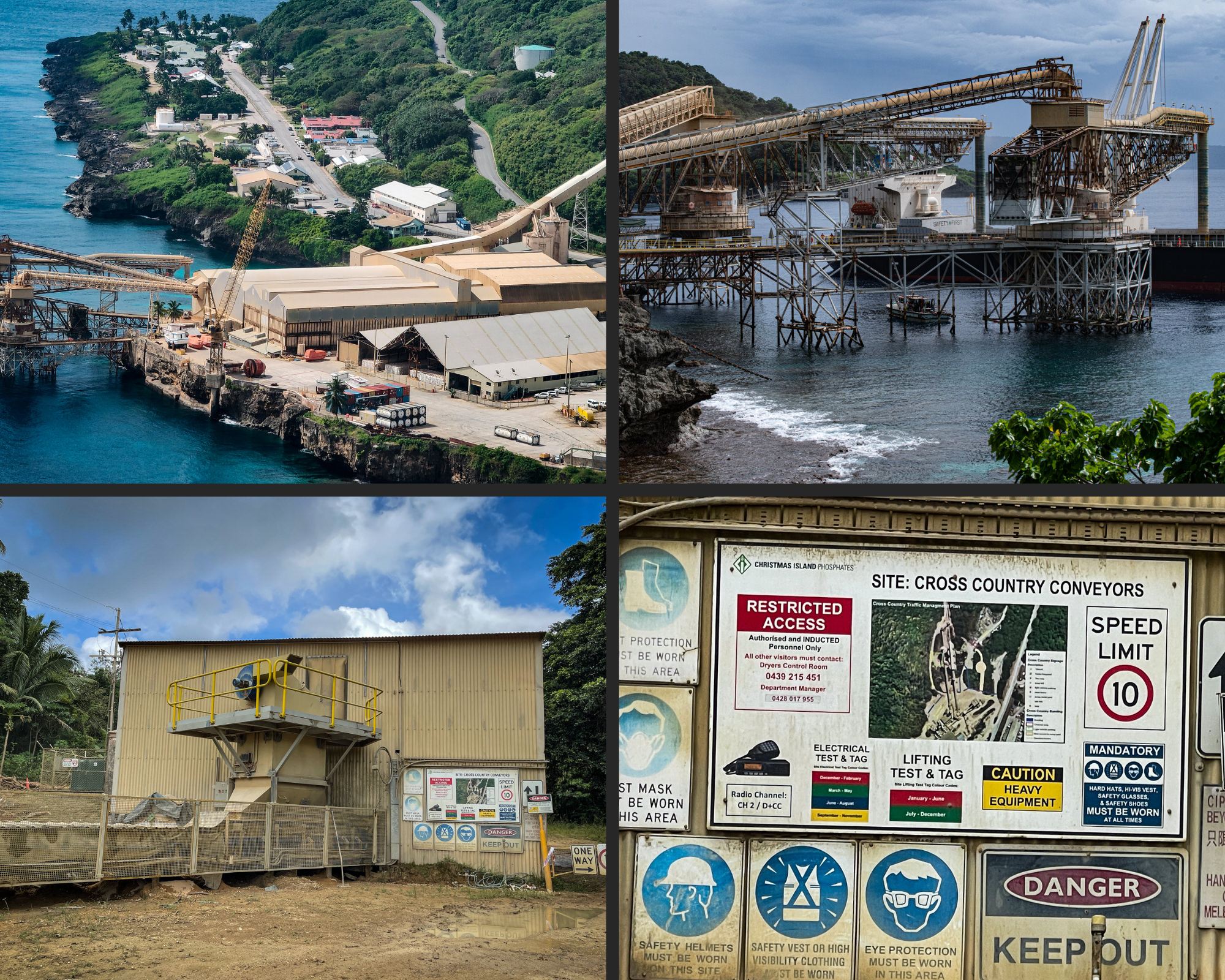
BOTTOM LEFT/RIGHT: Ore-laden carriages of phosphate in Dumpsite township
Today, the open cast mine sites number well above 125, but Phosphate Resources Limited has active re-vegetation projects to restore and rehabilitate habitat lost to mining.
Also, the Federal Government has repeatedly resisted approving any further exploration and expansion of the mine, as recent as 2018. Perhaps this may indicate that phosphate mining on the island will end when the current lease expires in 2034?
The Future of Christmas Island?
With active conservationists, a sympathetic Australian Government, and good local island management, there is great potential for ecotourism to replace the declining phosphate mining and all the local employment it generates.
The island certainly has a lot to offer. But it will need experienced and careful multi-level management to balance its wildlife and ecology so that it can be sustainable and enjoyed without detriment by environmentally sensitive tourists.
The island’s proximity to Southeast Asia is dutifully noted. But it is also only a 3-4 hour flight from Western Australia, similar to flying to Fiji from our eastern coast.
Planning a trip to Christmas Island should depend on what your particular interest is as its wildlife has specific times of the year when certain events occur. So, always look at the weather, temperature, and seasons before you travel.
How to Get There
Serviced exclusively by Virgin Australia there are two flights per week from Perth on Tuesday and Friday, dependent on weather conditions. Flight time is approx. 3 1/2 hours.
You will need a form of photographic identification (passport or driver’s license) and will still be required to fill out an International Arrival Card even though it is an Australian Shire or Territory.
Currently, during Covid-19, a fuel stop in Exmouth is required on the way to Cocos (Keeling) Islands, before heading on to Christmas Island.
Pre-Covid 19 there were also weekly Garuda flights from Jakarta, Indonesia. But please check with the Christmas Island Tourism Association for up-to-date details.
Where To Stay
For up-to-date information and bookings regarding travel and accommodation on the island, visit: https://www.christmas.net.au/ and https://parksaustralia.gov.au/christmas/discover
POSTSCRIPT: RESTRICTIONS TO ISLAND TRAVEL:
Irene and Tony Isaacson traveled to Christmas Island at their own cost in early May 2022. Covid-19 had just reached the island so some island tours were not available.
In addition, despite being the end of the rainy season, recent heavy rains had resulted in road closures from tree falls and muddy conditions. Access to Winifred Beach, Greta, and Dolly Beach was quite difficult. The Pink House Research Station (National Park Lizard Lodge) and Margaret Knoll were also closed, as were East-West Baseline Road, Boulder Track, and Circuit Tracks.
[Words by Irene Isaacson – Photos by Irene and Tony Isaacson]

Forgive my ignorance, what is IHMS??? But I know you will have a ball there! I only touched the surface in the short time we visited. There is so much to do, especially if you enjoy the outdoors, bush walks, wildlife, snorkeling/diving. You do need a car though, and always ask the locals for knowledge as some spots can be a little of the beaten track and if its wet, the roads can be boggy if not sealed. But you can get a personal alarm from the police station if you are going out a little remotely. The locals are very friendly and helpful too.
Thank you for this incredibly informative article on Christmas Island.
Thanks Christine, I’m glad you enjoyed reading it! I had sooo much more to say as it really is a great place to visit, but I didn’t want to write a book!
Thank you. As an IHMS worker on the island I’m grateful to have your insight to help me explore whilst I’m there.